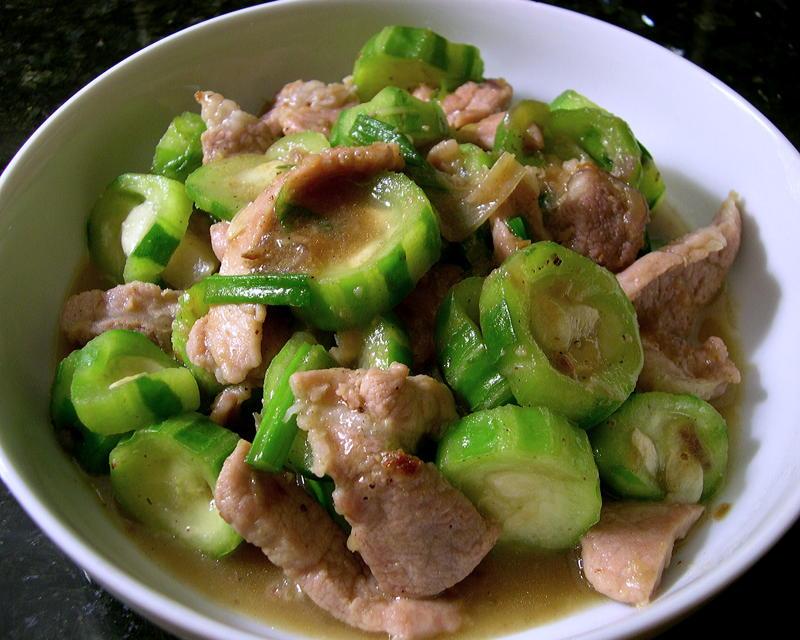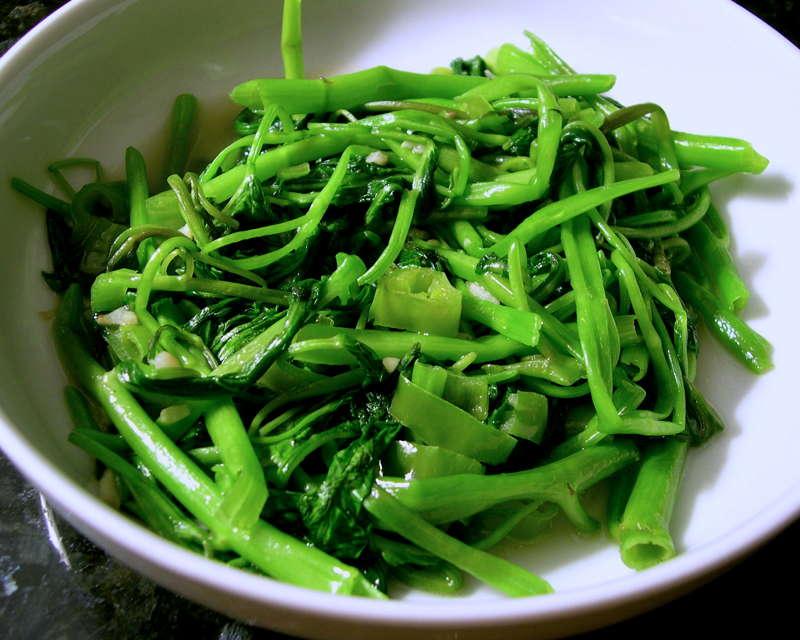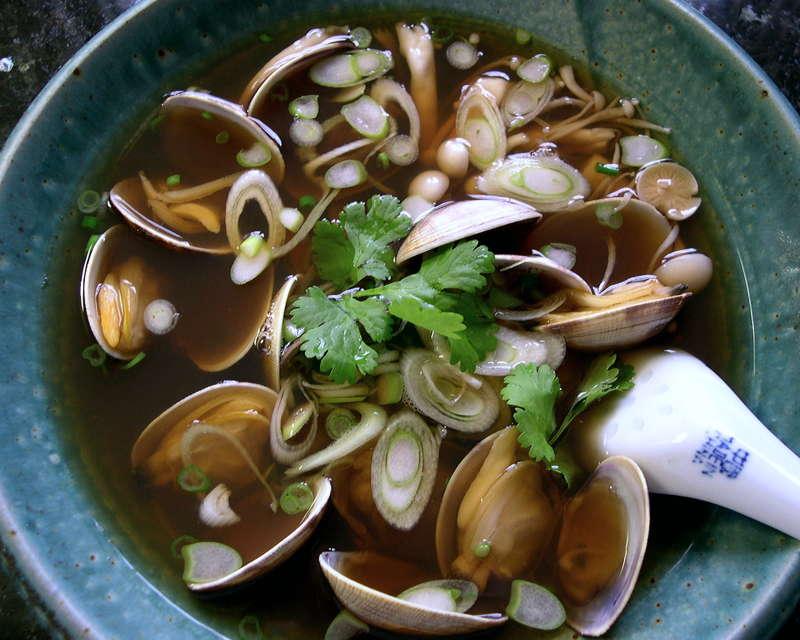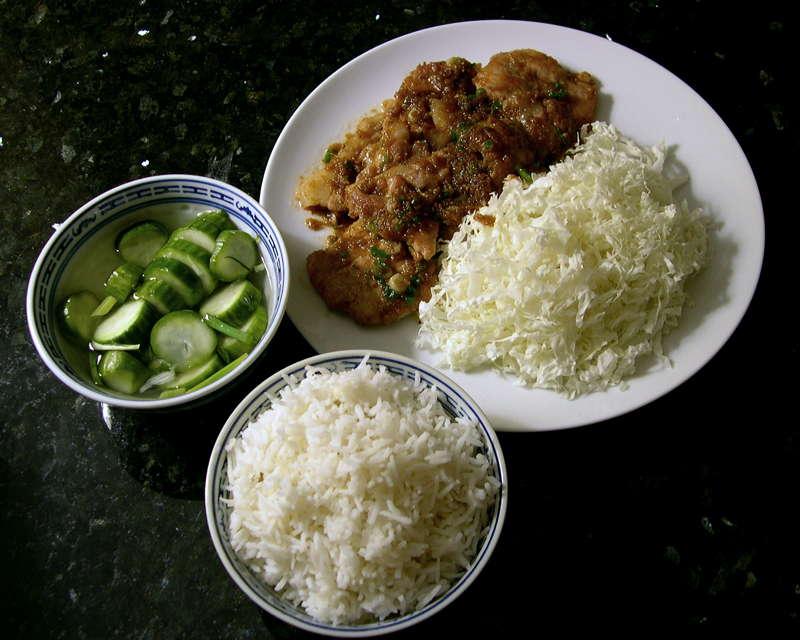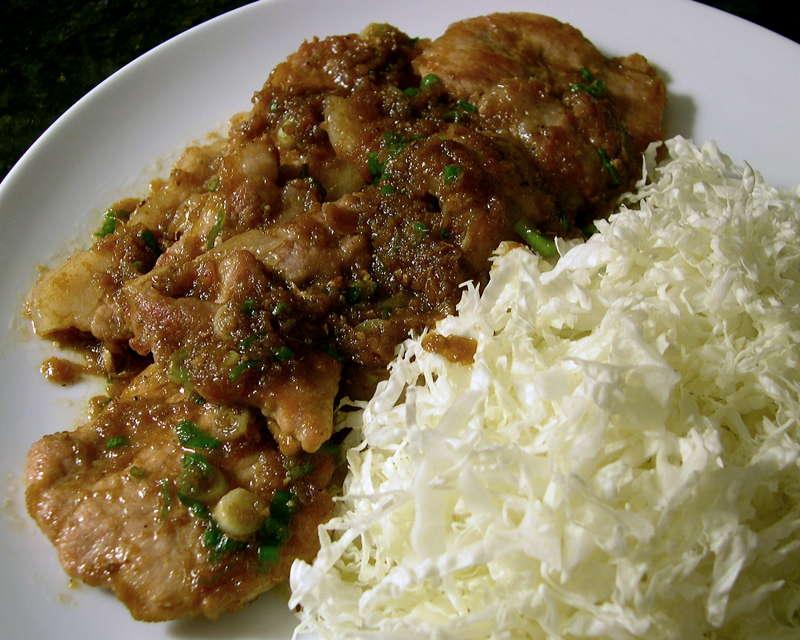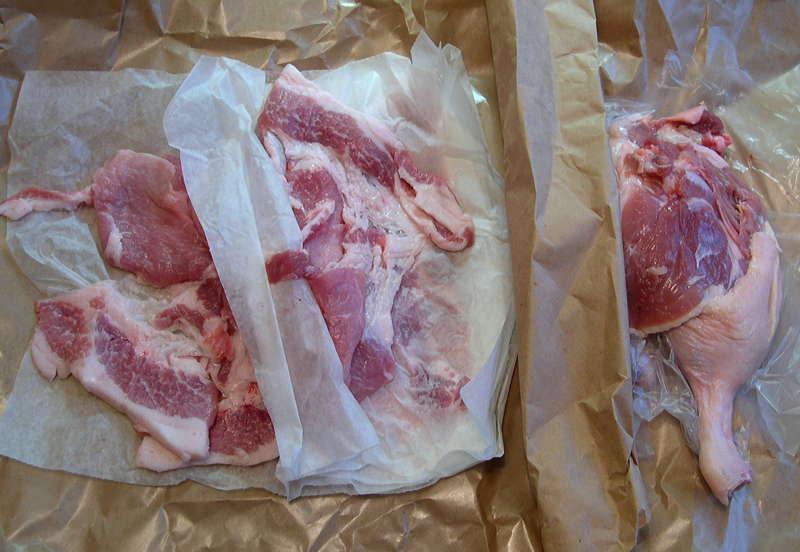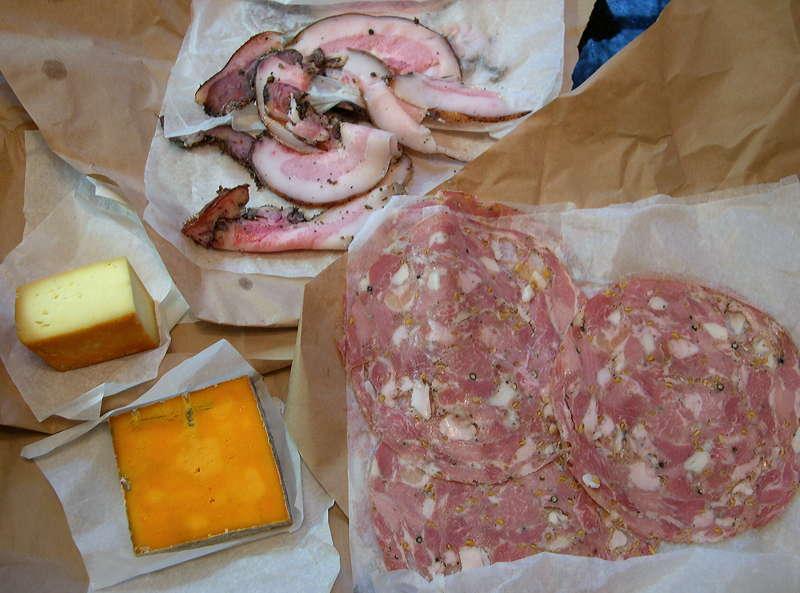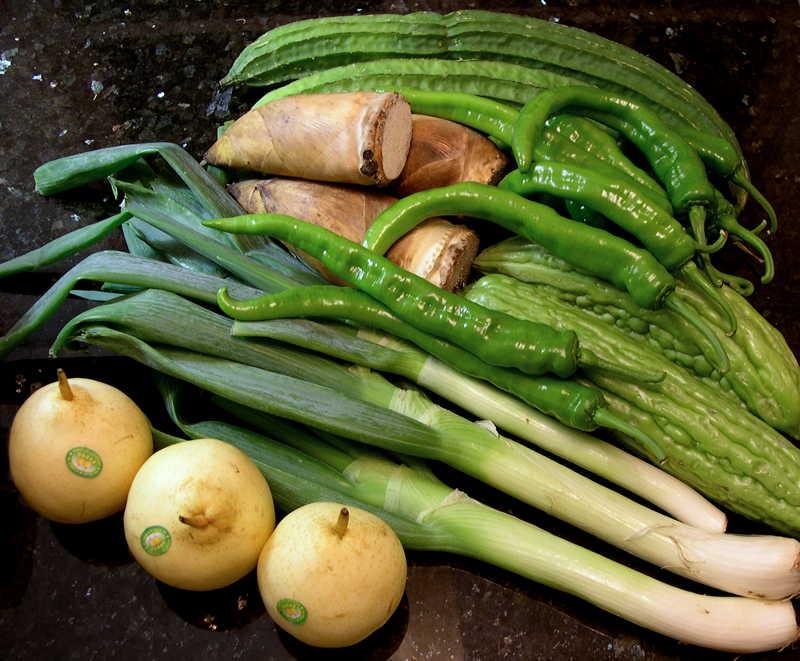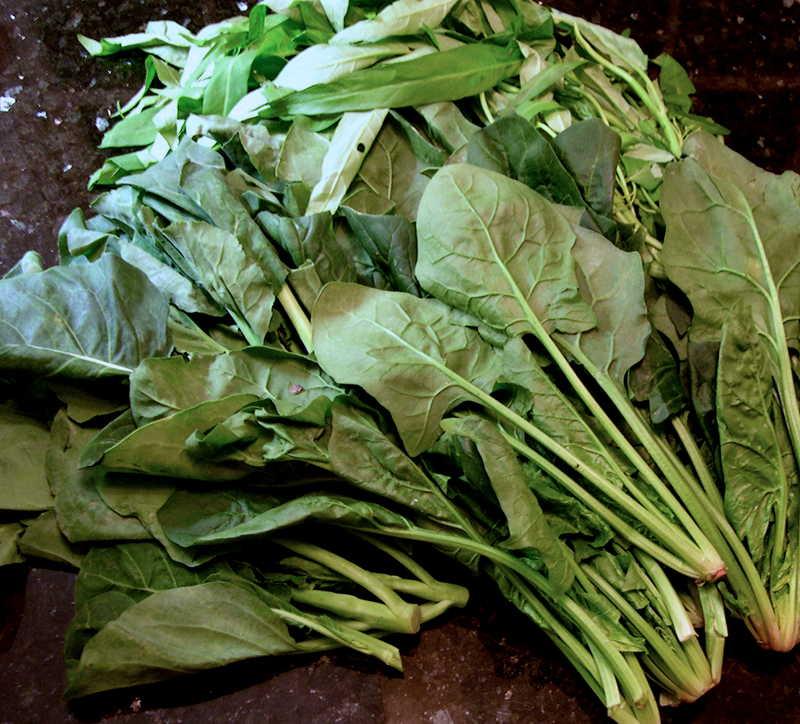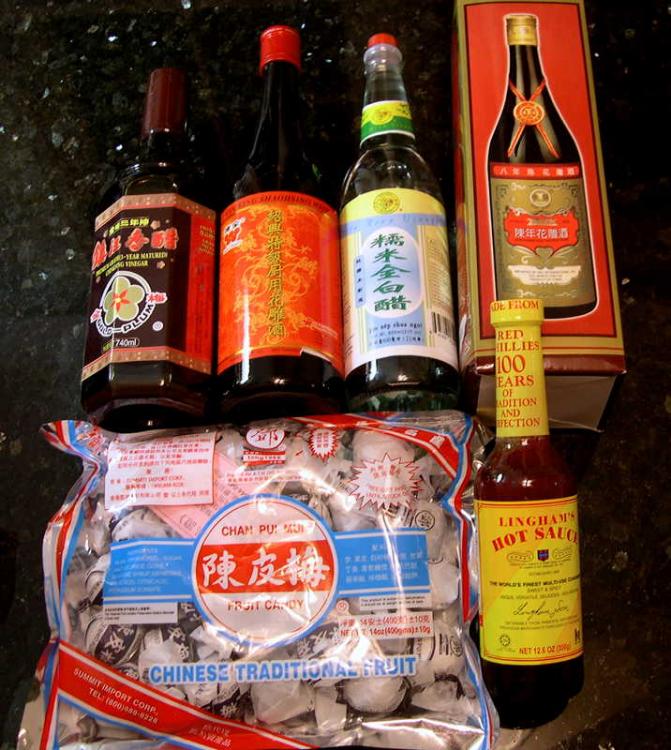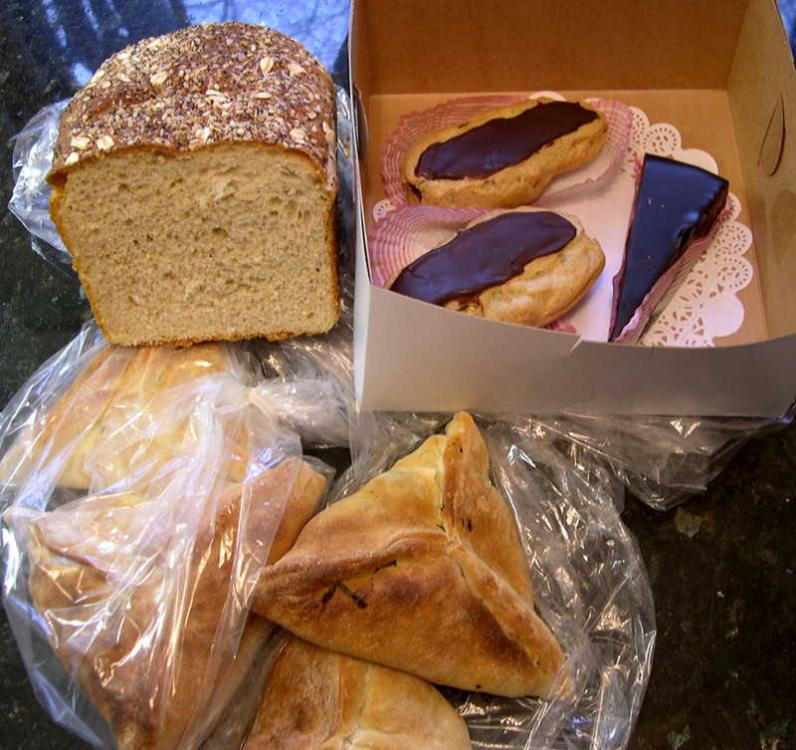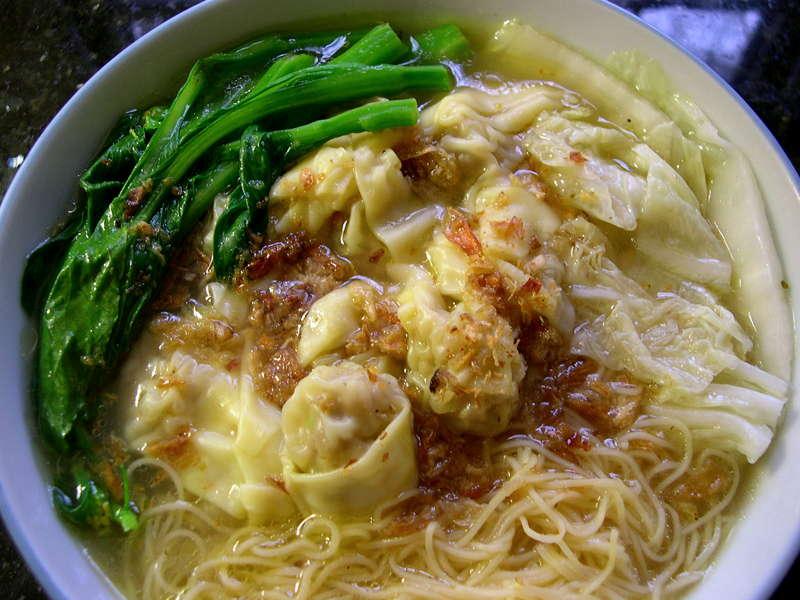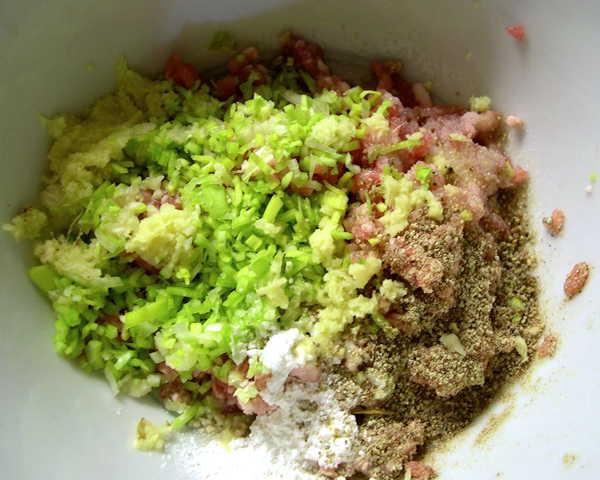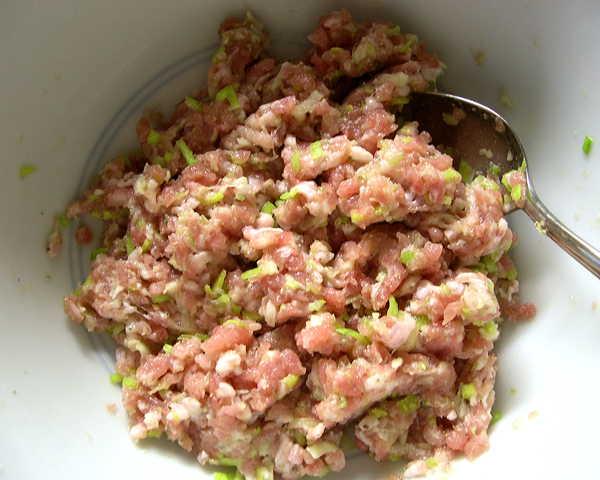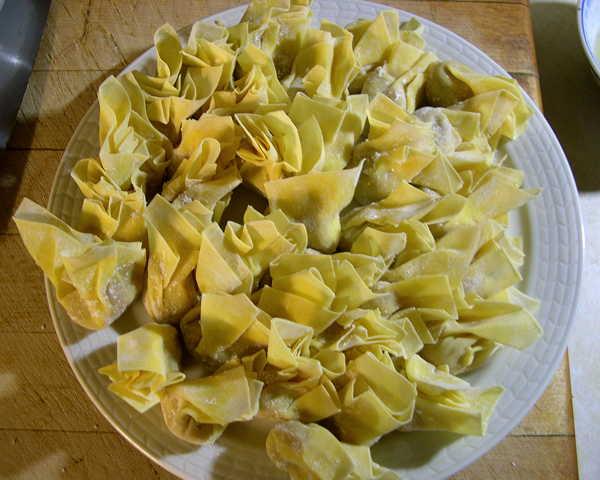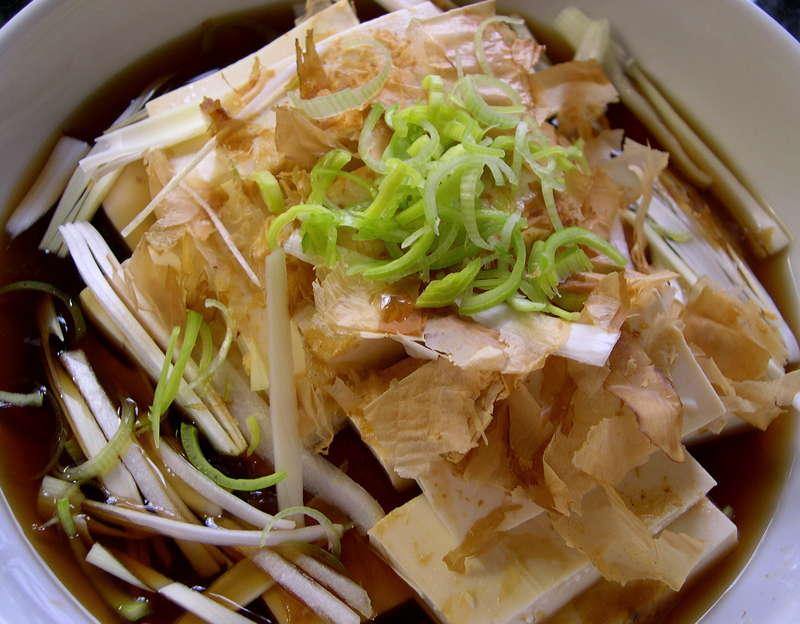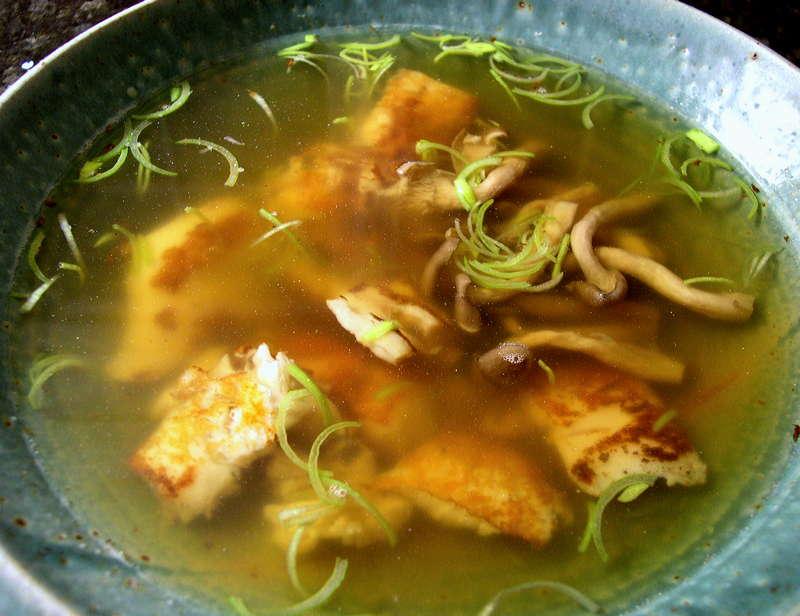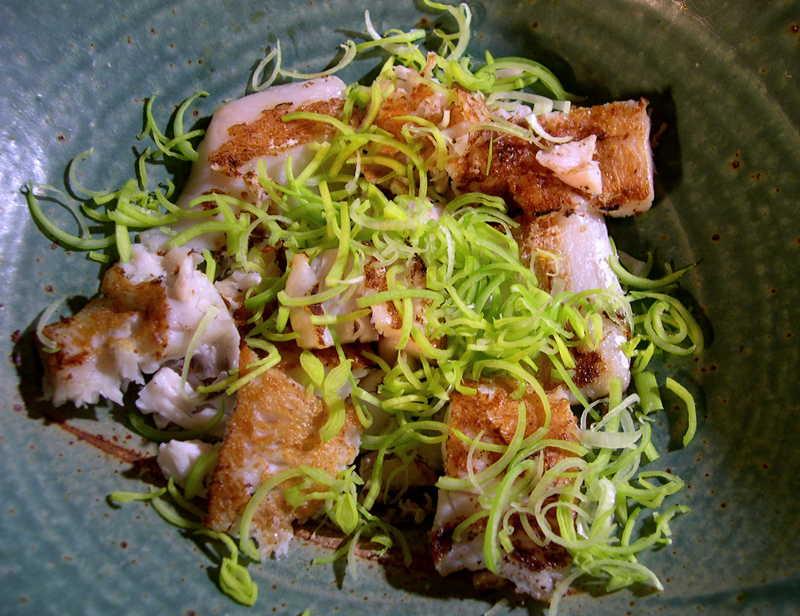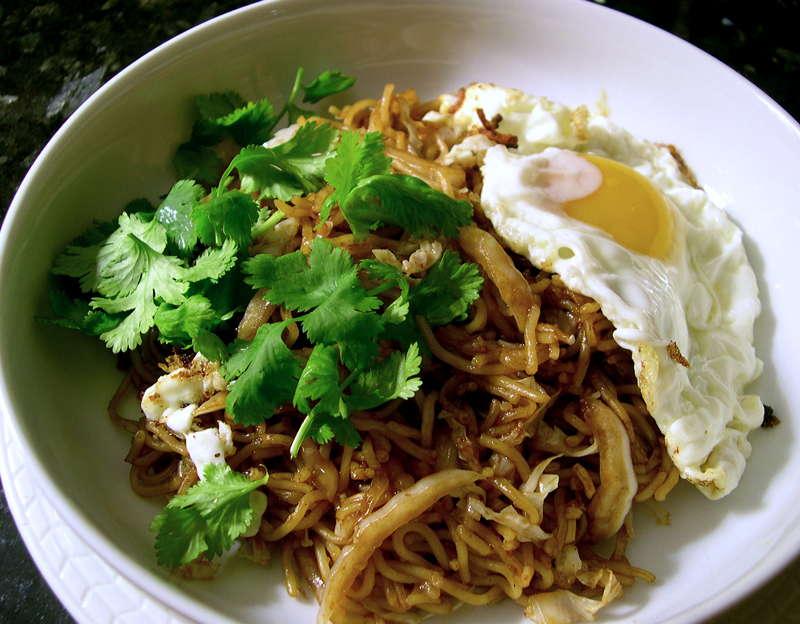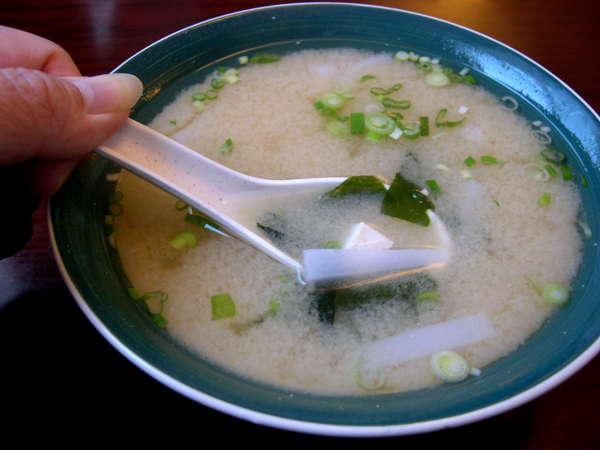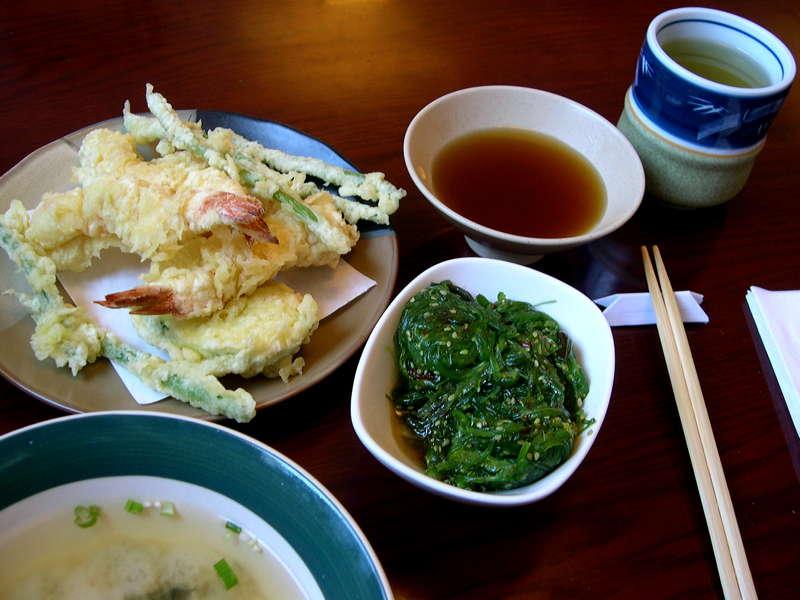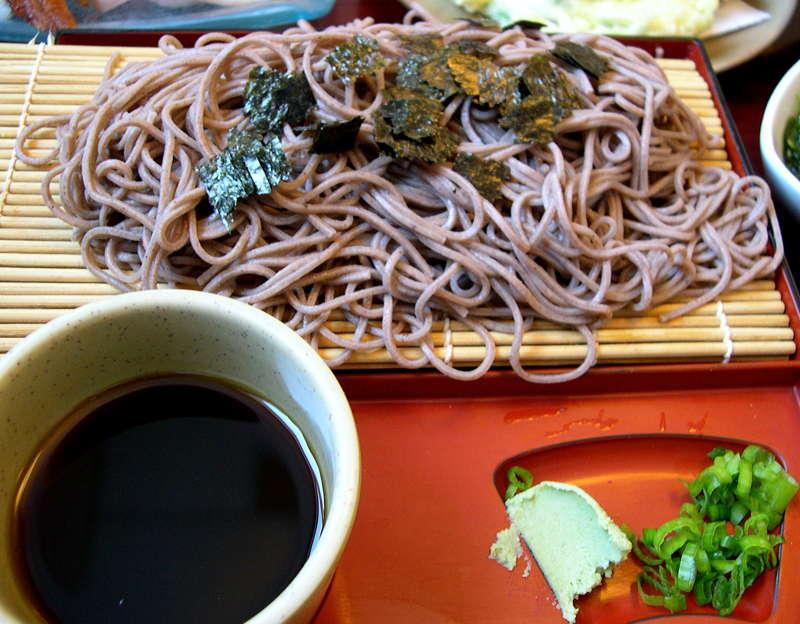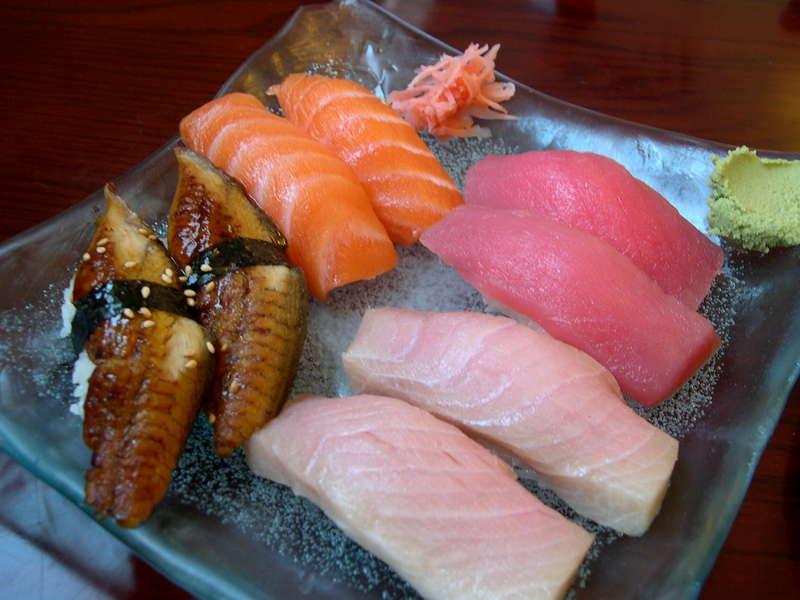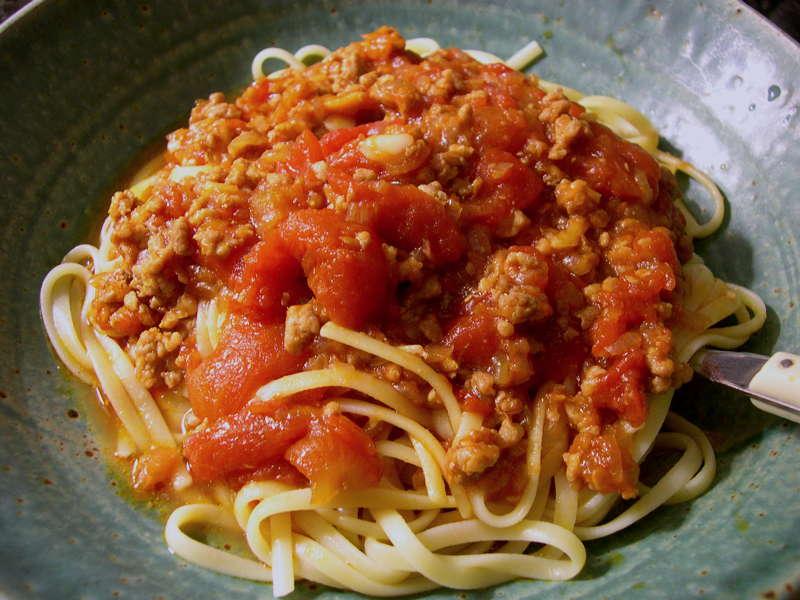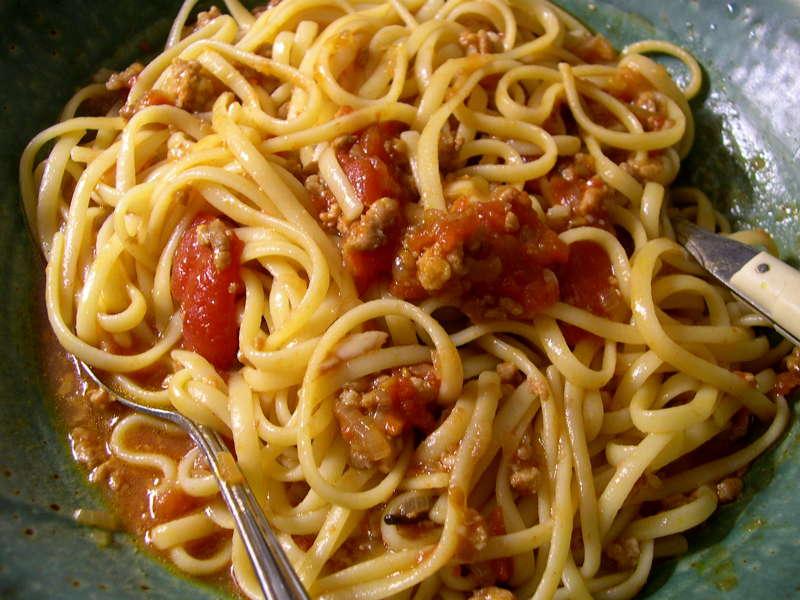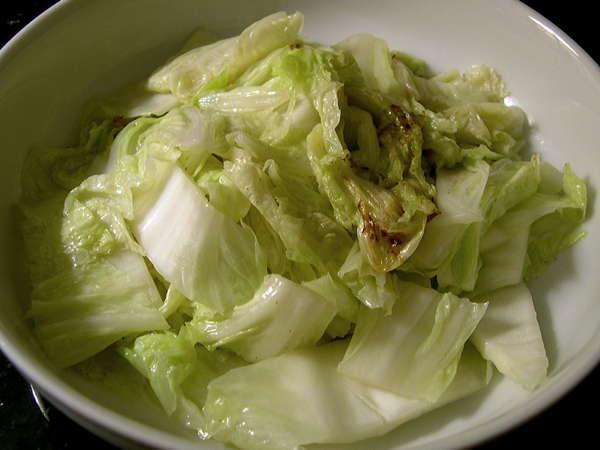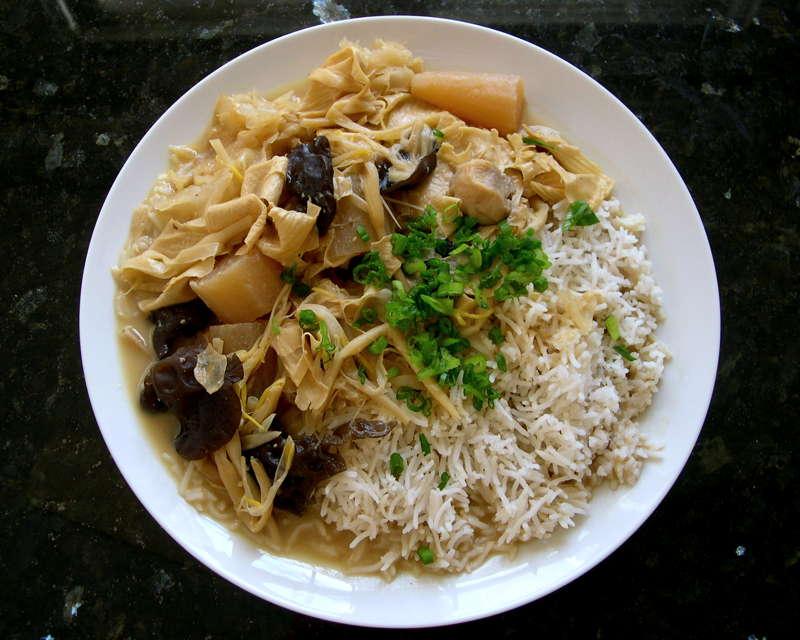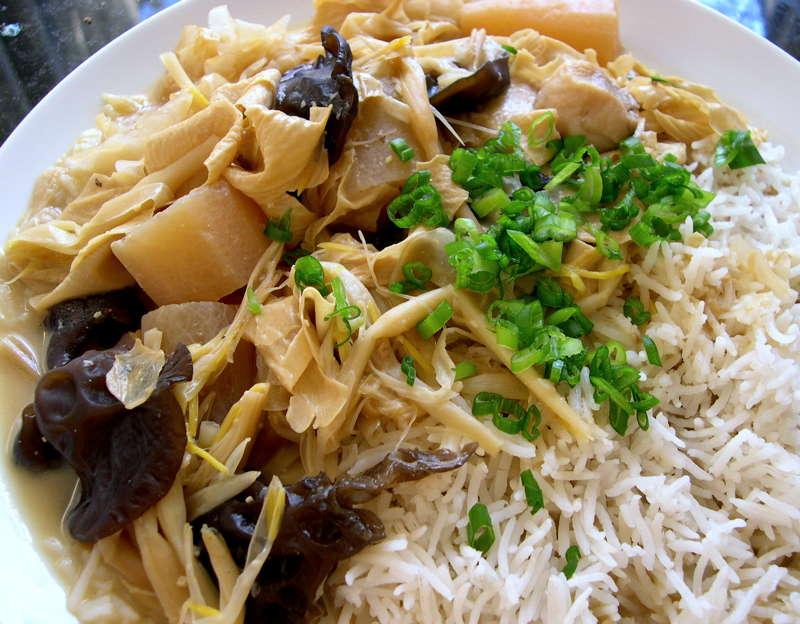-
Posts
3,810 -
Joined
-
Last visited
Content Type
Profiles
Forums
Store
Help Articles
Everything posted by huiray
-
Stir-fried loofah with pork. Mướp Xào Thịt Heo, one version. Closely based on this recipe. I used angled loofah (Luffa acutangula) and Berkshire pork loin sliced up, and lots of scallions. Peanut oil, sliced-up red cipollini onion, sauté till browning; pork slices (pre-marinated w/ sea salt, white pepper, palm sugar, corn starch, some oil), lightly crushed white parts of scallions trimmed to ~2 inches, "stir-fry" till half-done (more or less); de-ridged loofah sliced into rounds, fish sauce [Red Boat], fold/toss around, some water, stir some more, cover for a minute or two; more white pepper, trimmed green/upper parts of scallions (~2 inch pieces), a bit more palm sugar & fish sauce, toss around. Serve. Water spinach (kangkong a.k.a. ong choy a.k.a. rau muống; Ipomoea aquatica) stir-fried w/ chopped smashed garlic & a sliced de-seeded hot long green chilli. A modified rau muống xào tỏi. I skipped the fish sauce (or oyster sauce) customarily added and simply salted it. Hot peanut oil, salt, garlic, sliced chilli, trimmed washed water spinach. Toss around on high flame, cover briefly. Serve. Eaten with lots of white rice, of course.
-
Asari Osuimono, one version. Kombu dashi, Higeta Honzen soy sauce, ryori-shu, hon-dashi granules, bunapi-shimeji & enoki mushrooms, scrubbed pre-soaked "flower clams" (Venerupis). Broth/stock filtered. Scallions, negi & coriander leaves dressing. Buta no Shogayaki, one version. With white rice, julienned hakusai & pickled Persian cucumbers. Sliced pork loin (Berkshire), salt & pepper. Sautéed w/ rice bran oil, medium-hot pan. Then: Mixture of grated ginger & juices, Higeta Honzen soy sauce, Takara hon-mirin (the on the right), the clear part of Rihaku nigori 'Dreamy Clouds' sake; plus finely sliced scallions. Toss & cook down (a minute or so).
-
Some stuff from the Indy Winter Farmers' Market on Saturday - see here.
-
https://forums.egullet.org/topic/152191-dinner-2015-part-6/page-12?p=2037586#entry2037586
-
I kinda agree. A little on the overly Modernist side but it is sleek and appealing in its own way. However, it is not practical for me, or for folks similarly-inclined to do typical E/SE Asian cooking. No stir-frying appears feasible in that kitchen without MAJOR cleaning and wiping of everything within 50 feet of the stovetop, even if Induction stir-frying was attempted, especially if you are using the space to receive clients on a regular basis. Unless that exhaust sucked a major storm up the vents, but somehow I don't see this family doing much more than gentle simmering and not-quite-sautéeing and low-heat cooking. What if they had a power failure? Eh, I suppose they would simply get in the car and go out to eat - provided they can get the garage door open. It does look a bit like more of a showcase, even though he says they live in it. But then many years ago, I had a dinner with a young architect just starting out (in NYC) and he was raving about a just-completed building and complex which he described in glowing terms regarding the design and this and that. I passingly knew of the place and asked him how the people who worked there and used the spaces thought of it and whether it was user-friendly and welcoming. He replied, in all seriousness, "What's that got to do with it?" I could only blink a few times and change the subject of conversation. ETA: Another link with some more shots of the kitchen and surroundings.
-
Several fresh spinach pitas [Al-Basha] & Salame Cotto [Goose the Market]. See here, scroll down. All demolished. A very nice combo, very good munching. The sour-savory-bready character of the spinach pitas complimented the sweetish-salty-tangy-gelatinousness-savoriness of the cotto very well. I'd do this again eagerly. Plus a Nong Shim Kimchi Bowl beforehand. :-) Plus a chocolate eclair [Rene's Bakery] afterwards. :-D
-
Saturday 2015-1128 Indy WinterFarmers' Market: Purple curly kale, Tuscan (lacinato) kale, yellow & red cipollini onions, small portobello mushrooms, 2 big packs of free-range chicken frames/necks. Goose the Market: Fresh duck legs, thinly-sliced boneless pork loin (Berkshire), Porchetta di Testa (spiced & rolled cured pig face), Salame Cotto (large type), Red Rock cheese, Kokoborrego Gilead cheese. Asia Mart: 8-year Tang Brand Shaohsing wine, white rice vinegar [Golden Flower], 3-year Chinkiang vinegar [Gold Plum], Shaohsing cooking wine [Wei Chuan], Lingham's Hot Sauce, Chinese okra (Luffa acutangula), Persian cucumbers, bitter melon "#1", limes, long hot green chillies, Thai basil, ong choy (kangkong), Chinese long beans (Vigna unguiculata subsp. sesquipedalis), Cantonese "chow mein"-type noodles [Prime Food], fresh yakisoba [Maruchan], Chan Pui Mui (陳皮梅) (preserved sweet & sour plums), raw shelled peanuts, fresh Yali (鸭梨) pears (Pyrus x bretschneideri), Hinoichi soft & firm tofu, fried soy puffs [Nature's Soy], white beech mushrooms, enoki mushrooms, beef shanks, chicken feet, miso ramen packs [shirakiku], Jjajang Pokki noodle bowls, bamboo chopsticks. Viet Hua Food Market: Coriander leaves, scallions, negi/"cebollita", small kai-lan, red edible amaranth (紅莧菜), Chinese-type spinach, fresh winter bamboo shoots (冬筍), Venerupis clams (花蛤蜊; "flower clams"). Al-Basha Grocery: Spinach pita "turnovers". Rene's Bakery: Half a loaf of multi-grain bread, 2 chocolate eclairs, 1 slice Bête Noire.
-

Indianapolis Restaurant: Reviews & Recommendations
huiray replied to a topic in The Heartland: Dining
Naftal, you're welcome. -
Pork wonton noodle soup. (豬肉雲吞湯麵) Wontons: Minced pork, corn starch, finely chopped leek green, grated ginger w/ juices, sea salt, good Shaohsing wine, ground white pepper. Square Hong Kong style thin wonton wrappers [Twin Marquis]. Broth: Chicken stock simmered w/ de-headed ikan bilis, chopped garlic & broken-apart tea flower mushrooms, then filtered through a sieve. Accompaniments: Skinny wonton noodles [Twin Marquis], yu choy sum & wong nga pak both blanched in oiled simmering water, deep-fried shallots. Dang, forgot the coriander leaves which were left in the soaking water. On the way there:
- 494 replies
-
- 14
-

-
Well, the folks who were here first in "America" have a different view. http://www.truth-out.org/opinion/item/33781-no-thanks-how-thanksgiving-narratives-erase-the-genocide-of-native-peoples http://www.usatoday.com/story/news/2015/11/26/thanksgiving-not-popular-all-americans-especially-original-inhabitants/76417336/ http://www.statesmanjournal.com/story/opinion/2015/11/26/american-indians-view-thanksgiving-day/76420214/ http://www.boston.com/news/local/massachusetts/2014/11/26/national-day-mourning-reflects-thanksgiving-horrific-bloody-history/I4gK8GwU9r2JtJnpyjGWhM/story.html
-
"The Last Thanksgiving".
-
Hiyayakko, of sorts. Soft tofu, pressed for a while. Cut into chunks, dressed w. katsuobushi, slivered leek whites, sliced leek greens. Tentsuyu-type sauce, from a mixture of hon-mirin, water, kelp-flavored natural brewed soy sauce, ryori-shu, etc. Fish osuimono. Fish: Barramundi, marinated in ryori-shu, blotted dry, sliced up, dressed lightly w/ sea salt, pan-seared/cooked in a dry, un-oiled medium-hot pan, removed to serving bowl, dressed w/ sliced leek greens. Broth: Cold water, konbu, bring to boil; add kelp-flavored brewed soy sauce, sake, hon-dashi granules, salt, shaved lime rind; bring back to a simmer, reduce heat to lowest setting, leave a while; add small/baby oyster mushrooms, leave on low heat for a while more. Filter, add to fish pieces & leeks in bowl; oyster mushrooms added to bowl. Fish & leeks in bowl before broth added: Pan-fried yakisoba w/ sliced hakusai (Napa cabbage), plus a fried egg. Dressed w. coriander leaves.
-

Indianapolis Restaurant: Reviews & Recommendations
huiray replied to a topic in The Heartland: Dining
Naftal, insofar as I am aware there are various dipping sauces in Japanese cuisine which are commonly (or not infrequently?) drunk – or at least partially so, such as sipping from it. That dipping shoyu (tentsuyu & etc) for the tempura, for example, is drinkable and I did sip some of it too. Certainly the sauce for agedashidofu is fully drinkable as-is, if prepared in the usual manner, ditto many "dipping sauces" and whatnot which are normally dilute forms of a dashi with one or another soy sauce and/or mirin/sake etc. Mentsuyu is also drinkable (and are drunk) if not too salty or if diluted further with some sort of broth or liquid - like from the soup of a bowl of noodles one is having alongside. At least I would do so. Most Chinese dipping sauces, on the other hand, tend to be more "concentrated" and more salty anyway and I can't think of one off the top of my head that is drunk as-is, if at all. But I might think of one later. There is also a fairly broad grey area between "soup/broth" and "sauce" and one bleeds into the other depending on what it is and what is done to it. Even Chinese steamboat (and the Japanese equivalent, shabu-shabu) start out with broths (or even water) and as one keeps cooking stuff in it this "broth"/liquid becomes more and more intense in favor and starts transitioning from broth to dipping sauce, so to speak, especially as the volume goes down as the cooking and eating and heating of the broth goes on. ;-) Depending on how one makes a nabe, I would also think, it might put one in another grey area between broth/soup and sauce. :-D Then in something like Klang-style Bak Kut Teh the dish is prepared and served with a fairly thick liquid (as contrasted with the definitely soupy KL or Teochew or otherwise Canto-Hoklo versions) which could be fairly thought of as a sauce - but this is definitely "eaten", but perhaps more in terms of being spooned over rice. Drinking it is certainly done, but one sips it as opposed to gulping it down – as it is pretty concentrated! As for sauces in various SE Asian curries and related dishes --- of course that is also drunk, again in relatively smaller gulps, as well as eating with the carbohydrate of one's choice. :-) Perhaps I should stop here... -
I was referring to what tamagoyaki is and how to make it.
-
https://forums.egullet.org/topic/145079-omelette-how-do-you-make-yourfavorites/page-4?p=1920823#entry1920823
-

Indianapolis Restaurant: Reviews & Recommendations
huiray replied to a topic in The Heartland: Dining
That is it, basically. Add the seasonings to one's taste. One then simply takes some of the soba with one's chopsticks, dip it into the sauce, and...eat it. :-) The bowl can be taken from the tray and held up closer to the lips when doing so. I often literally dunk the soba into the sauce (releasing it from my chopsticks) before fishing it out, all the better to trap some of the chopped scallions scattered into the sauce; but I also simply dip/dunk it in without releasing the soba. :-) It would be nice if places served sliced negi rather than plain ol' scallions. What I have not seen around here is the offering of the sobayu as well (the water used to cook the soba) alongside the zaru. Traditionally, this still-warm cooking water (presented in a small teapot thingie, say) is poured into the sauce at the end and one then drinks the whole shebang. And yes, the tray is positioned with the dipping bowl on the side closer to you with the soba away from you, as in the picture. The bowl is usually on the left side (if not in the center) because most folks are right-handed (sorry, Southpaws) so the left hand is used to hold/carry the bowl while the soba is picked up with the chopsticks in the right hand. ;-) -
Tomatoes in Vietnamese cuisine --- "authentic", insofar as it has been absorbed into the cuisine. I touched upon this aspect in my defense some time ago of "prawns in tomato sauce" advocated by a TC contestant, which was slammed by the TC judges (Colicchio in particular) --- but, but - such a dish is very much a part of the Vietnamese culinary landscape in Vietnam for many years now. One could say that too of Pho, for that matter. :-) Ditto "Omelettes", which encompass much more than a certain very specific way of doing it if viewed from a strictly Western European perspective which might have been applicable in the 17th Century but is no longer so. Similarly for many other things. P.s. Chicken Tikka Masala has been re-imported into India and is offered in many places there in the last few decades. There has also ensued disputes about the origins of the dish (natch), heh. Several years ago I remarked (on another *cough,cough* food forum) about the listing of General Tso's Chicken on a Chinese Restaurant's menu (in a prominent hotel in Kuala Lumpur) and on the menu of a Singaporean local restaurant's menu. Re-importation, in both cases. Cross-fertilization, in other terms. As for the Singaporean restaurant - it turned out (from the exchange on that forum in that thread) that the owner-chefs of the place had cooked for many years in NYC and, on their return to Singapore, wanted to express just a bit of what they had been cooking in The New World.
-
Primarily E/SE Asian variety, but I imagine it can be extended to all cuisines. http://www.newyorker.com/culture/cultural-comment/chinese-food-and-the-joy-of-inauthentic-cooking
-

Indianapolis Restaurant: Reviews & Recommendations
huiray replied to a topic in The Heartland: Dining
Lunch at Ichiban Noodles today. I had not been back for quite a while, but I used to go there frequently. Nothing extraordinary about the food but the stuff there is pretty decent and satisfactory. Good value too, and they seem to have held the line fairly well since the last time I was there. Same owner and staff, all a little older of course. But aren't we all getting older. It was gratifying that they recognized me at once when I walked in. What I had today - a mixture of favorites from before, all simple stuff, never mind concepts of "balanced and paired" dishes according to traditional Japanese notions. :-D A big bowl of miso soup to start with, gratis. The server remembered my penchant for large bowls of it too. :-) Tempura appetizer plate (shrimp, zucchini slice, sweet potato slice, green beans), plus the dipping shoyu; Seaweed salad in a tangy ponzu sauce (there are cucumber batons at the bottom); A mug of hot green tea. I skipped getting some agedashidofu. :-( Zaru soba. Dressed w/ nori. Dipping tsuyu, "fake" wasabi, scallions. The soba was well prepared, as always. (Folks unfamiliar with eating zaru soba please feel free to ask about it) Small selection of nigirizushi – salmon, tuna, yellow tail, eel. Yum. Burp. Pic of one of the interior dining rooms, taken from my table. Pic of the place from outside. Location on Google maps. -
Oops, plus some smashed garlic added in halfway through light browning of the onions.
-
Tangy meat sauce with pasta. I've made this sauce off-and-on over several decades. This time I used pork mince rather than beef mince. Coarse brunoise of small sweet yellow onions, rice bran oil, medium heat, onions softened & lightly browned. Pork mince added, stirred around, clumps broken up somewhat. Generous tomato ketchup (yes, ketchup) [Heinz, "Simply Heinz"] squeezed in, stirred around on medium heat, a bit of browning of edges allowed. Canned peeled whole plum tomatoes (this time I used SMT brand, San MericanTM tomatoes, heh.) with juices added, tomatoes chopped into quarters with the spatula, mixture stirred around. A small handful of whole cloves and a half of a hefty stick of cassia bark added in, mixture simmered on. A decent amount of good rice vinegar added, plus a good shot of hon-mirin (rather than the rock sugar or palm sugar I use more frequently) and a couple shots of double fermented soy sauce [LKK]. Everything was stirred around and then simmered (covered) till the oil "broke" (more like separated at the top) (like with many curries) (this is the minimum "doneness" I seek) plus a while more till I was satisfied. :-) Eaten w/ linguine [Rustichella d'Abruzzo] as the delivery system. ;-) Plus some stir-fried wong nga pak (Napa cabbage).
- 494 replies
-
- 10
-

-
Franci, have you tried growing costata romanesco?
-
The braised daikon from here allowed to steep overnight, the large solids removed and reserved. The liquids were fortified with cubes of fermented wet bean curd (白腐乳) [Liu Ma Kee] slurried with some water, the mixture diluted a bit, seasoning adjusted, then used to braise (stove top) additional dried golden needles (金針) (rehydrated and the stem ends nipped off, as before/usual) and after a little while dried oiled bean curd sheets (腐竹 / 腐竹皮) snapped into smaller pieces folded in and the mixture simmered a while more. The reserved solids were added back in and the whole simmered till judged satisfactory, liquids adjusted. Recap of the other ingredients in this: daikon (白蘿蔔), tea flower mushrooms (茶花菇), wood-ear fungus (木耳), snow fungus (雪耳), shiro miso, garlic, oil. Eaten w/ white rice, dressed w/ finely sliced green parts only of scallions. Plus more of the Kiam Chye Ark Th'ng from before, taste mellowed after sitting overnight, diliuted a bit and resimmered. (If one wishes, search the forum for Itek Tim for representative pictures of this that I have made before)
-
Well, the Fox News article (I highly distrust Fox News anyway) *did* talk about their doing away with the dollar menu quite some time ago and had been trying various approaches to replacing it, like their other competitors also have been struggling with in their menus. McD's getting rid of the Dollar Menu is not a recent thing. Here's another recent view on the matter: http://www.businessinsider.com/mcdonalds-value-menu-mcpick-2-2015-11
-
Duck & pickled mustard soup (Itek Tim a.k.a. Kiam Chye Ark Th'ng). Duck legs, water, galangal, garlic, tamarind pulp, salted plums in brine plus some of the brine, pickled mustard, rock sugar. Braised daikon & mushrooms. Young daikon, dried "tea flower mushrooms", dried wood-ear fungus, dried snow fungus, dried golden needles, stove-top braise w/ garlic, shiro miso & stuff.


